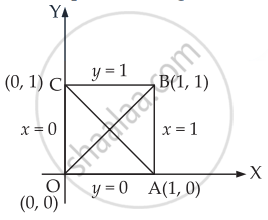Advertisements
Advertisements
Question
Equations of diagonals of the square formed by the lines x = 0, y = 0, x = 1 and y = 1 are ______.
Options
y = x, y + x = 1
y = x, x + y = 2
2y = x, y + x = `1/3`
y = 2x, y + 2x = 1
Solution
Equations of diagonals of the square formed by the lines x = 0, y = 0, x = 1 and y = 1 are y = x, y + x = 1.
Explanation:

Given equation x = 0, y = 0
x = 1 and y = 1 form a square of side 1 unit
From figure, we get that OABC is square having corners O(0, 0), A(1, 0), B(1, 1) and C(0, 1)
Equation of diagonal AC
y – 0 = `(1 - 0)/(0 - 1) (x - 1)`
⇒ y = – (x – 1)
⇒ y = – x + 1
⇒ y + x = 1
Equation of diagonal OB is y – 0 = `(1 - 0)/(1 - 0) (x - 0)`
⇒ y = x
APPEARS IN
RELATED QUESTIONS
Without using the Pythagoras theorem, show that the points (4, 4), (3, 5) and (–1, –1) are the vertices of a right angled triangle.
Find the angle between the x-axis and the line joining the points (3, –1) and (4, –2).
Find the slope of a line passing through the following point:
\[(a t_1^2 , 2 a t_1 ) \text { and } (a t_2^2 , 2 a t_2 )\]
State whether the two lines in each of the following is parallel, perpendicular or neither.
Through (6, 3) and (1, 1); through (−2, 5) and (2, −5)
Using the method of slope, show that the following points are collinear A (16, − 18), B (3, −6), C (−10, 6) .
The slope of a line is double of the slope of another line. If tangents of the angle between them is \[\frac{1}{3}\],find the slopes of the other line.
Consider the following population and year graph:
Find the slope of the line AB and using it, find what will be the population in the year 2010.

Line through the points (−2, 6) and (4, 8) is perpendicular to the line through the points (8, 12) and (x, 24). Find the value of x.
Find the value of x for which the points (x, −1), (2, 1) and (4, 5) are collinear.
A quadrilateral has vertices (4, 1), (1, 7), (−6, 0) and (−1, −9). Show that the mid-points of the sides of this quadrilateral form a parallelogram.
Find the equation of a straight line with slope − 1/3 and y-intercept − 4.
Find the equations of the bisectors of the angles between the coordinate axes.
Show that the perpendicular bisectors of the sides of a triangle are concurrent.
Prove that the points (2, −1), (0, 2), (2, 3) and (4, 0) are the coordinates of the vertices of a parallelogram and find the angle between its diagonals.
Show that the tangent of an angle between the lines \[\frac{x}{a} + \frac{y}{b} = 1 \text { and } \frac{x}{a} - \frac{y}{b} = 1\text { is } \frac{2ab}{a^2 - b^2}\].
Write the coordinates of the image of the point (3, 8) in the line x + 3y − 7 = 0.
If m1 and m2 are slopes of lines represented by 6x2 - 5xy + y2 = 0, then (m1)3 + (m2)3 = ?
The line passing through (– 2, 0) and (1, 3) makes an angle of ______ with X-axis.
Find the equation of the straight line passing through (1, 2) and perpendicular to the line x + y + 7 = 0.
The two lines ax + by = c and a′x + b′y = c′ are perpendicular if ______.
Find the equation of the line passing through the point (5, 2) and perpendicular to the line joining the points (2, 3) and (3, – 1).
If the equation of the base of an equilateral triangle is x + y = 2 and the vertex is (2, – 1), then find the length of the side of the triangle.
The equation of the straight line passing through the point (3, 2) and perpendicular to the line y = x is ______.
Line joining the points (3, – 4) and (– 2, 6) is perpendicular to the line joining the points (–3, 6) and (9, –18).
| Column C1 | Column C2 |
| (a) The coordinates of the points P and Q on the line x + 5y = 13 which are at a distance of 2 units from the line 12x – 5y + 26 = 0 are |
(i) (3, 1), (–7, 11) |
| (b) The coordinates of the point on the line x + y = 4, which are at a unit distance from the line 4x + 3y – 10 = 0 are |
(ii) `(- 1/3, 11/3), (4/3, 7/3)` |
| (c) The coordinates of the point on the line joining A (–2, 5) and B (3, 1) such that AP = PQ = QB are |
(iii) `(1, 12/5), (-3, 16/5)` |
The line which passes through the origin and intersect the two lines `(x - 1)/2 = (y + 3)/4 = (z - 5)/3, (x - 4)/2 = (y + 3)/3 = (z - 14)/4`, is ______.
A ray of light coming from the point (1, 2) is reflected at a point A on the x-axis and then passes through the point (5, 3). The co-ordinates of the point A is ______.
The three straight lines ax + by = c, bx + cy = a and cx + ay = b are collinear, if ______.
